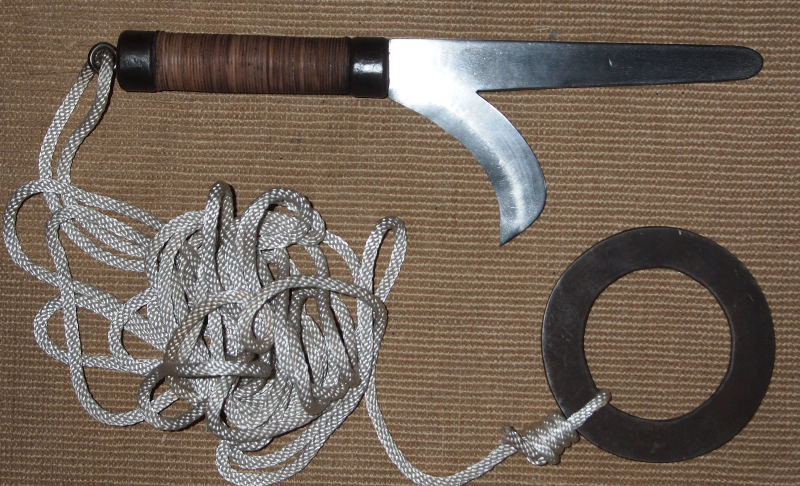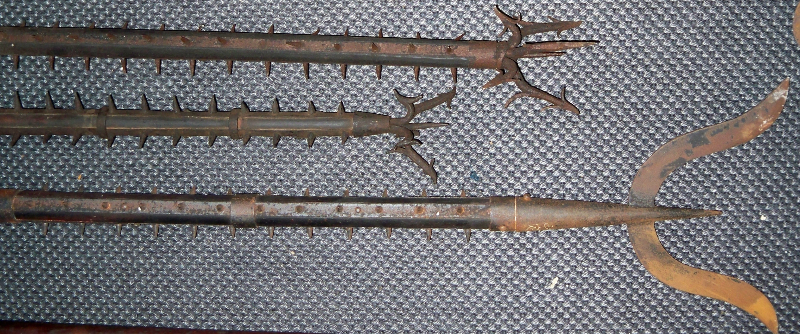
THE TEKKAN | 鉄管
The tekkan, also known as tetsu-ken or tetto , is a Japanese weapon that was used during the Edo period until the beginning of the 20th century. It was an iron truncheon that became very popular with wealthy merchants and farmers, since such people were forbidden by law from carrying or possessing swords or other edged weapons.The tekkan, bearing no edge, had always been permitted by law.

Photo By : Samuraiantiqueworld
THE KUNAI | 苦無

THE KUSARIGAMA | 鎖鎌

THE KANABO | 金棒

The chigiriki | 契木
The chigiriki is a Japanese flail weapon that belong to the furi-zue family of weapon, It consists of a solid or hollow wood (sometimes bamboo) or iron staff with an iron weight and chain on the end, sometimes retractable. The chigiriki is a more aggressive variation of the parrying weapon kusarigama. It can be used to strike or entangle the opponent as well as to parry his blows and to capture or incapacitate an opponents weapon. This weapon is said to be used by the Kiraku-ryū and the Araki-ryū schools

Photo By : Samuraiantiqueworld
The kyoketsu-shoge | 距跋渉毛
The kyoketsu-shoge ,which means "to run about in the fields and mountains", is a double edged blade, with another curved blade attached near the hilt. This is attached to approximately 10 to 18 feet (3–5 m) of rope, chain, or hair which then ends in a large metal ring. Likely used by ninja of the Iga province, it is thought to be a forerunner to the later more widely known kusarigama. The kyoketsu-shoge has a wide range of uses. The blade could be used for pulling slashes as well as thrusting stabs. The chain or cord, sometimes made from human hair or horsehair for strength and resiliency, could be used for climbing, ensnaring an enemy, binding an enemy and many such other uses.

Photo By : Budoka720
The JUTTE | 十手
The Jutte which translate to " The ten hand" is a specialized weapon that was used by police in Edo period Japan (1603 – 1868) . In feudal Japan, it was a crime punishable by death to bring a sword into the shōgun's palace. This law applied to almost everyone, including the palace guards. Due to this prohibition, several kinds of non-bladed weapons were carried by palace guards. The jitte proved particularly effective and evolved to become the symbol of a palace guard's exalted position.
THE KATANA | かたな
A katana is a Japanese sword distinguished by a blade length of approximately 60 cm and characterized by a curved, single-edged blade with a circular or squared guard and long grip to accommodate two hands. it was used by samurai in feudal Japan and worn with the blade facing upward. The official term for katana in Japan is uchigatana (打刀) and the term katana (刀) often refers to single-edged swords from around the world.

Photo By : Emmanuel H
The sasumata | 刺股
The sasumata is a pole weapon used by the samurai class and their retainers in feudal Japan. In Edo period, the samurai were in charge of police operations. Various levels of samurai police with help from non-samurai commoners used many types of non-lethal weapons to capture suspected criminals uninjured for trial. The head of the sasumata would be used to catch around the neck, arms, legs, or joints of a suspect and detain him until officers could close in and apprehend him.

Photo By : Samuraiantiqueworld
THE SHURIKEN | 手裏剣
A shuriken which translate to "hidden hand blade" is a Japanese concealed weapon that was used as a hidden dagger or metsubushi to distract or misdirect. They are also known as throwing stars, or ninja stars, although they were originally designed in many different shapes. Contrary to what is portrayed in modern movies, the shuriken were not in the arsenal of those who practised ninjutsu but mainly used by samurai and ashigaru soldiers as a supplementary weapons to the sword or various other weapons in a samurai's arsenal.

THE TEKKO KAGI |
HIYA TAIHOU | ひやたいほう










0 Comments